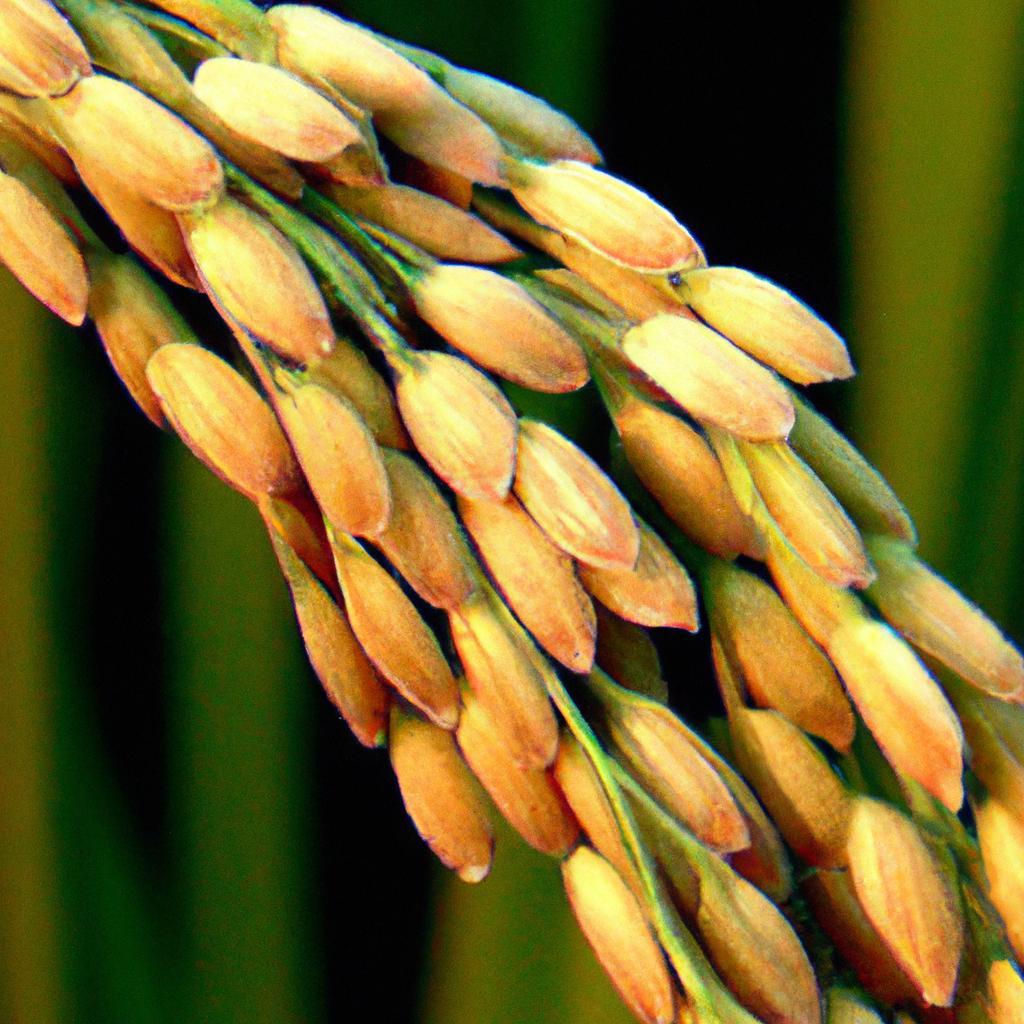In a bustling kitchen, a chef stood before a pot of simmering rice, pondering its true identity. Is rice merely a grain, or is it the heart of countless cultures? As she stirred, memories flooded in—family gatherings, fragrant dishes, and the comforting warmth of shared meals. Rice, a staple for billions, transcends its classification; it embodies nourishment, tradition, and unity. So, while technically a grain, rice is much more—it’s a symbol of connection, a canvas for culinary creativity, and a testament to our shared humanity. Embrace rice, not just as a grain, but as a vital part of our global tapestry.
Contents
- Understanding the Botanical Classification of Rice as a Grain
- Nutritional Benefits of Rice: A Grain Worth Including in Your Diet
- Culinary Versatility of Rice: Elevating Meals with a Staple Grain
- Sustainable Rice Production: Supporting Environmental and Economic Health
- Q&A
Understanding the Botanical Classification of Rice as a Grain
Rice, a staple food for over half of the world’s population, is classified botanically as a grain. More specifically, it belongs to the family Poaceae, commonly known as the grass family. Within this family, rice is categorized under the genus Oryza, with the most widely cultivated species being Oryza sativa. This classification highlights rice’s characteristics as a cereal grain, which is defined as the edible seeds of certain grasses.
As a grain, rice is primarily composed of carbohydrates, making it an essential energy source. The structure of rice grains includes three main parts: the bran, the germ, and the endosperm. Each of these components plays a crucial role in the grain’s nutritional profile:
- Bran: The outer layer rich in fiber, vitamins, and minerals.
- Germ: The nutrient-packed core that can sprout into a new plant.
- Endosperm: The starchy part that provides energy and is the bulk of the grain.
Rice is not only a grain but also a versatile food ingredient that can be processed into various forms, including white rice, brown rice, and rice flour. Each type offers different nutritional benefits and culinary uses, appealing to diverse dietary preferences. Brown rice, for instance, retains the bran and germ, making it a whole grain that is higher in fiber and nutrients compared to its white counterpart, which has been milled to remove these components.
Understanding rice’s classification as a grain is essential for appreciating its role in global agriculture and cuisine. This classification not only informs us about its botanical characteristics but also underscores its importance as a food source. By recognizing rice as a grain, we can better understand its nutritional value, its cultivation practices, and its cultural significance across different societies. Embracing rice in its various forms can lead to healthier eating habits and a deeper appreciation for this vital crop.
Nutritional Benefits of Rice: A Grain Worth Including in Your Diet
When considering the nutritional profile of rice, it’s important to recognize its status as a staple food in many cultures around the world. This versatile grain is not only a source of energy but also offers a variety of essential nutrients that contribute to a balanced diet. Rice is primarily composed of carbohydrates, which provide the body with the fuel it needs for daily activities. However, it also contains a range of vitamins and minerals that are vital for overall health.
One of the standout features of rice is its low fat content. This makes it an excellent option for those looking to maintain a healthy weight or reduce their fat intake. Additionally, rice is naturally gluten-free, making it a safe choice for individuals with gluten sensitivities or celiac disease. This inclusivity allows rice to be enjoyed by a diverse range of diets, from vegetarian to gluten-free, without compromising on taste or nutrition.
Rice also serves as a good source of essential vitamins, particularly when consumed in its whole grain form, such as brown rice. Whole grain rice retains the bran and germ, which are packed with nutrients like B vitamins, iron, and magnesium. These vitamins play crucial roles in energy metabolism, immune function, and maintaining healthy bones. Incorporating whole grain rice into your meals can significantly enhance your nutrient intake while providing a satisfying texture and flavor.
Moreover, rice is a versatile ingredient that can be paired with a variety of foods, making it easy to incorporate into your daily meals. Whether served as a side dish, in salads, or as a base for stir-fries, rice can complement a wide range of flavors and cuisines. By including rice in your diet, you not only enjoy its nutritional benefits but also its ability to enhance the overall culinary experience, making it a grain worth including in your meals.
Culinary Versatility of Rice: Elevating Meals with a Staple Grain
Rice is not just a staple food; it is a culinary chameleon that adapts beautifully to a myriad of dishes across cultures. Its ability to absorb flavors makes it an ideal base for a variety of cuisines, from the aromatic biryanis of India to the delicate sushi of Japan. The versatility of rice allows it to be transformed into both savory and sweet dishes, proving that this humble grain can elevate any meal to new heights.
Incorporating rice into your meals opens up a world of possibilities. Consider the following options:
- Risottos: Creamy and rich, risottos can be customized with seasonal vegetables, seafood, or mushrooms, showcasing the grain’s ability to absorb flavors.
- Stir-fries: Quick and easy, rice serves as the perfect canvas for vibrant vegetables and proteins, making it a go-to for busy weeknight dinners.
- Rice Puddings: Sweetened with sugar and flavored with vanilla or cinnamon, rice can be transformed into a comforting dessert that delights the senses.
Moreover, rice can be prepared in various forms, each offering a unique texture and taste. From fluffy steamed rice to crispy fried rice, the cooking method can significantly alter the dish’s character. Experimenting with different types of rice, such as jasmine, basmati, or arborio, can further enhance the dining experience, allowing chefs to tailor their meals to specific flavor profiles and textures.
rice is not only versatile in its culinary applications but also in its nutritional benefits. It serves as a gluten-free alternative for those with dietary restrictions, while also providing essential carbohydrates for energy. By incorporating rice into your meals, you can create balanced dishes that satisfy both the palate and the body, making it an indispensable ingredient in any kitchen.
Sustainable Rice Production: Supporting Environmental and Economic Health
Rice is not just a staple food for billions around the globe; it is also a vital component of sustainable agricultural practices that can significantly enhance both environmental and economic health. By adopting eco-friendly farming techniques, rice production can reduce its carbon footprint while ensuring food security. This dual benefit is crucial in a world facing climate change and increasing population pressures.
Implementing practices such as integrated pest management, crop rotation, and water-efficient irrigation systems can lead to healthier ecosystems. These methods not only minimize the use of harmful chemicals but also promote biodiversity. Farmers who embrace these sustainable practices often see improved soil health and increased resilience against pests and diseases, ultimately leading to higher yields and better quality rice.
Moreover, sustainable rice production can stimulate local economies. By focusing on organic and environmentally friendly practices, farmers can tap into the growing market for eco-conscious consumers. This shift not only enhances their profitability but also encourages the development of local supply chains, creating jobs and fostering community resilience. The economic benefits extend beyond the farm, positively impacting local businesses and services.
Investing in sustainable rice production is an investment in the future. By prioritizing environmental stewardship and economic viability, we can ensure that rice remains a reliable food source for generations to come. The transition to sustainable practices is not merely a trend; it is a necessary evolution that supports the health of our planet and the prosperity of our communities.
Q&A
-
What is rice classified as?
Rice is classified as a grain, specifically a cereal grain. It is the seed of the Oryza sativa plant and is a staple food for more than half of the world’s population.
-
Are all grains the same as rice?
No, not all grains are the same as rice. Grains can be categorized into two main types: whole grains and refined grains. Rice falls under the category of whole grains when it is unprocessed, retaining its bran and germ.
-
Is rice a healthy grain option?
Yes, rice can be a healthy grain option, particularly brown rice, which is a whole grain. It is rich in fiber, vitamins, and minerals, making it a nutritious choice for a balanced diet.
-
Can rice be part of a gluten-free diet?
Absolutely! Rice is naturally gluten-free, making it an excellent choice for individuals with gluten sensitivities or celiac disease. It serves as a versatile base for many gluten-free meals.
understanding whether rice is a grain is essential for appreciating its role in our diets and agriculture. Embracing rice as a vital grain not only enriches our meals but also supports sustainable food practices. Let’s celebrate this staple!




